QNAP TVS-h1288X CPU Performance
Since a big part of QNAP’s value proposition is the ability to run applications and virtual machines on its NAS units, we wanted to share why the selection of the Intel Xeon W-1250 is such a differentiated choice. Having a higher clock speed processor means we get a lot of performance that we can use for NAS/ storage, but also for running virtual machines, containers, and applications.
Python Linux 4.4.2 Kernel Compile Benchmark
This is one of the most requested benchmarks for STH over the past few years. The task was simple, we have a standard configuration file, the Linux 4.4.2 kernel from kernel.org, and make the standard auto-generated configuration utilizing every thread in the system. We are expressing results in terms of compiles per hour to make the results easier to read:
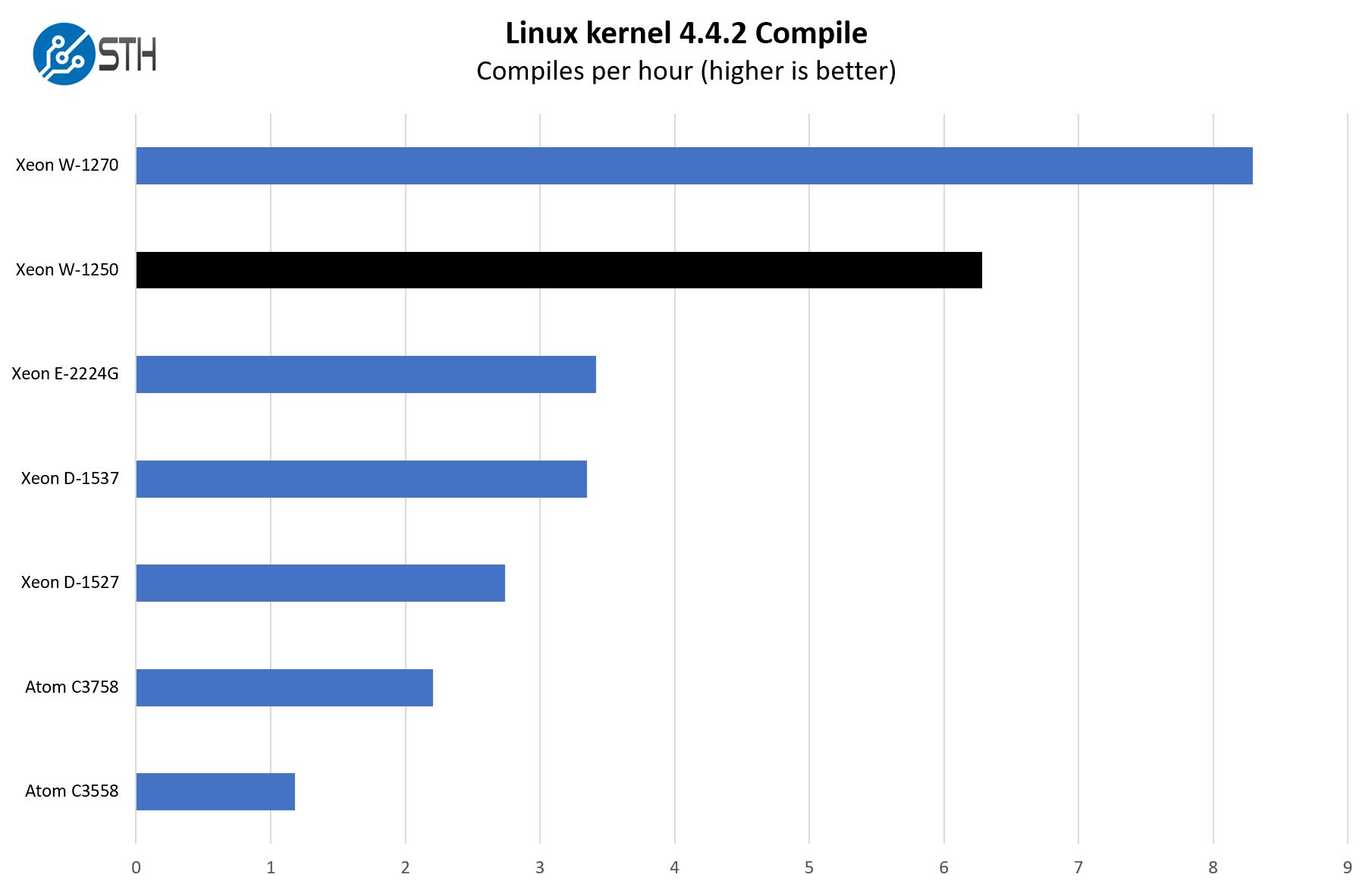
Overall, we wanted to highlight a major difference between what QNAP is doing here and some of the competitive offerings. For example, Synology’s $2500 12x 3.5″ bay DiskStation DS3617xs uses the Xeon D-1527. We can see a massive difference in CPU performance here.
7-zip Compression Performance
7-zip is a widely used compression/ decompression program that works cross-platform. We started using the program during our early days with Windows testing. It is now part of Linux-Bench.
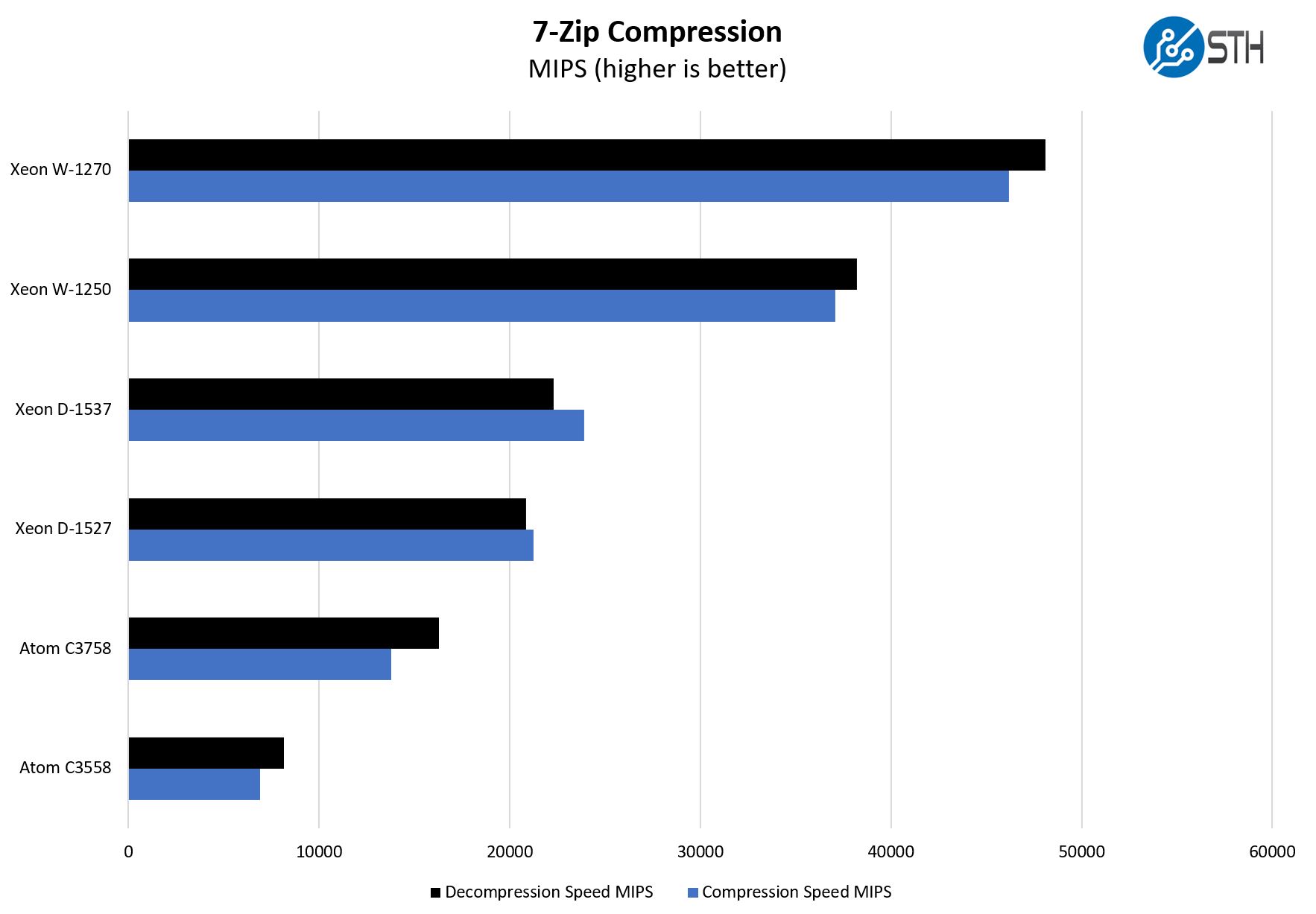
There are other offerings, such as the ZFS-based iXsystems TrueNAS Mini X+/ XL+ that use the Atom C3758 and one can see the clear benefit of the higher speed/ performance cores here. QNAP is effectively using a higher-performing CPU to enable better virtualization performance rather than just providing storage services.
OpenSSL Performance
OpenSSL is widely used to secure communications between servers. This is an important protocol in many server stacks. We first look at our sign tests:
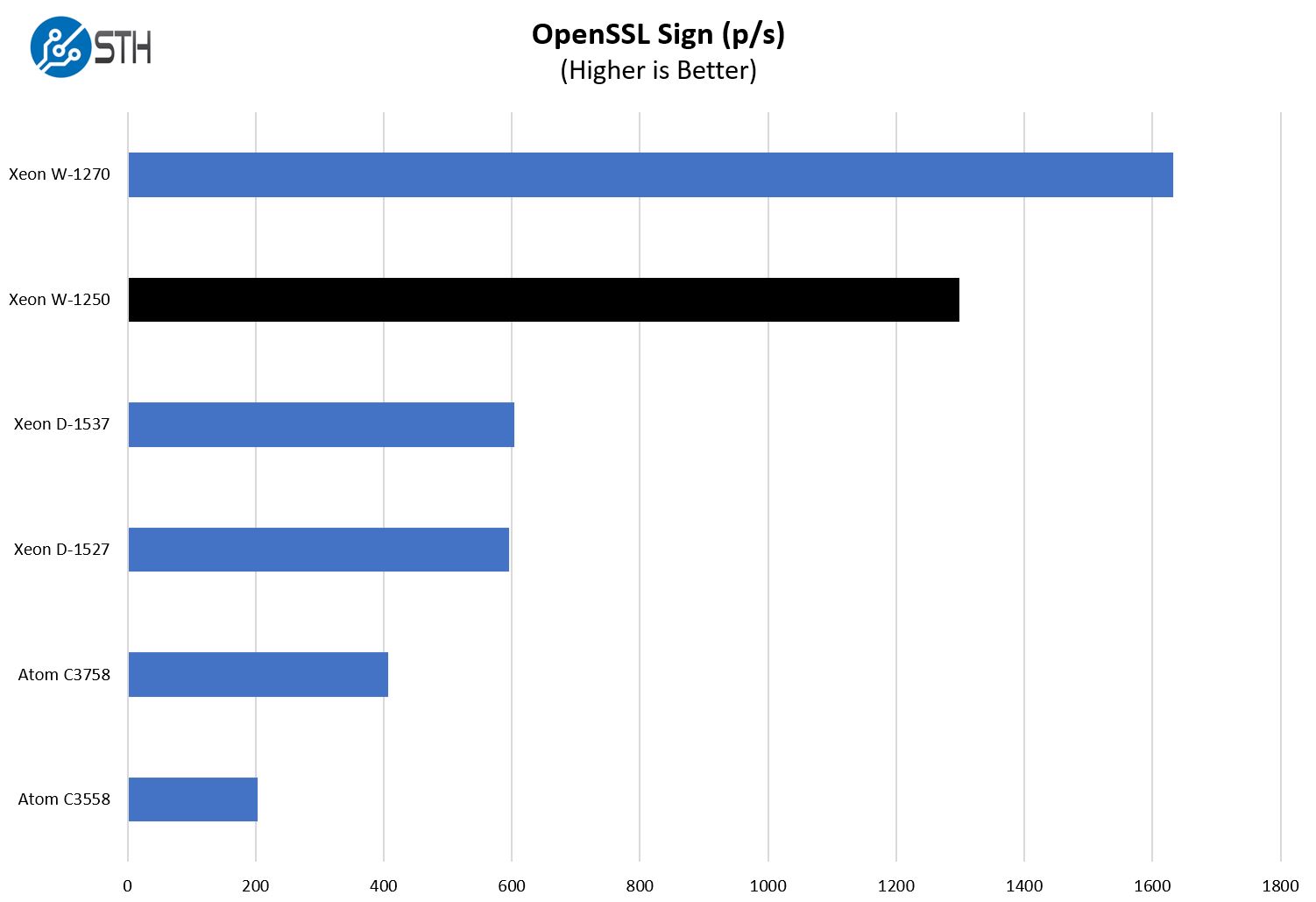
Here are the verify results:
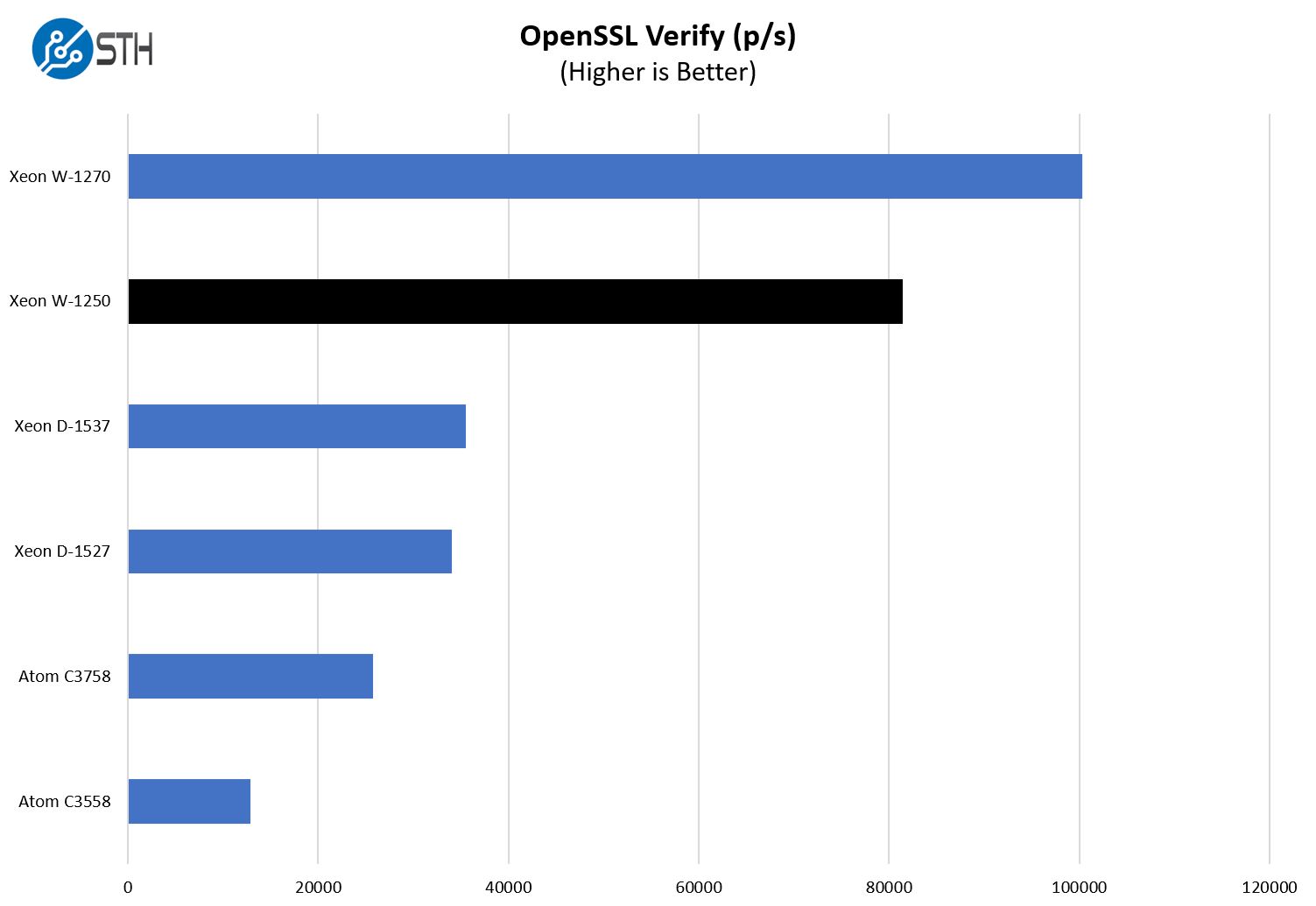
As a quick note, the Xeon D-1500 series was launched in 2015 and the Intel Atom C3000 launched in 2017. As a result, the 2020 Xeon W with a higher TDP is going to be a higher-performing part. Even if you just need basic file services, the newer platform has USB 3.2 Gen2 where the older platforms do not.
Storage Performance
The storage performance of these systems is very dependent on the disk configuration including drives used, cache SSDs, compression/ deduplication, and even RAM/ other applications running on the NAS. We still wanted to show the impact of moving to 10GbE 10GbE as the performance over 2.5GbE was quite eye-catching.
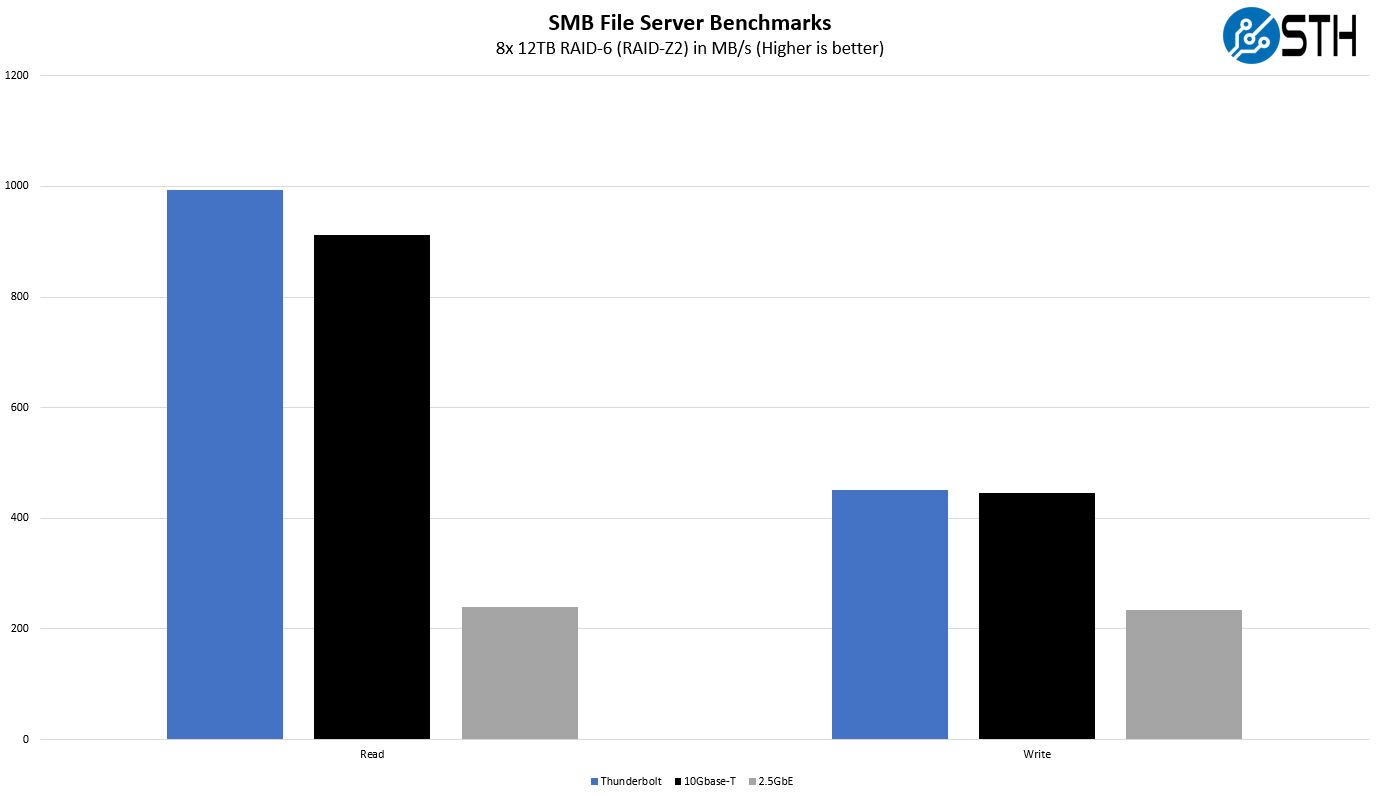
Here is another view looking at the file transfer speeds.
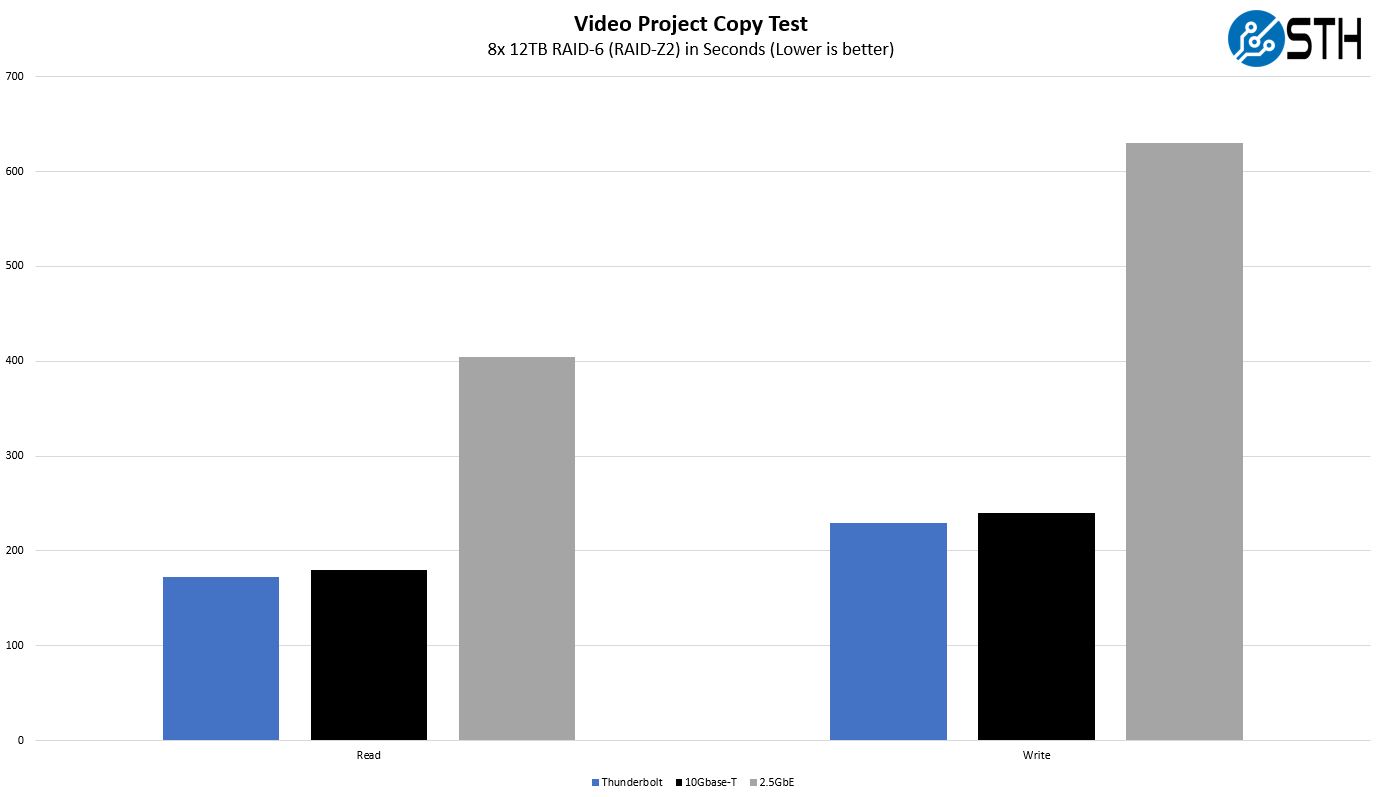
Overall performance was good. It seems as though our Thunderbolt connectivity was more limited by array speed rather than interface speed.
Power Consumption and Noise
The power consumption is dominated by disks and add-in cards. We debated whether we should test this in our 208V data center lab or in our 120V embedded edge data center lab. In the end, we are using 120V edge lab at 17.7C and 70% RH. Our testing window shown here had a +/- 0.3C and +/- 2% RH variance.
- Idle empty: 100W
- Max observed: 172W
It seems as though the 550W power supply configuration is ample for this unit. We did get a bit of variance at idle but the range was more like 98-102W so we are using the average. This is a bit different than many of the workstations and servers we test where idle variances are within 1W.
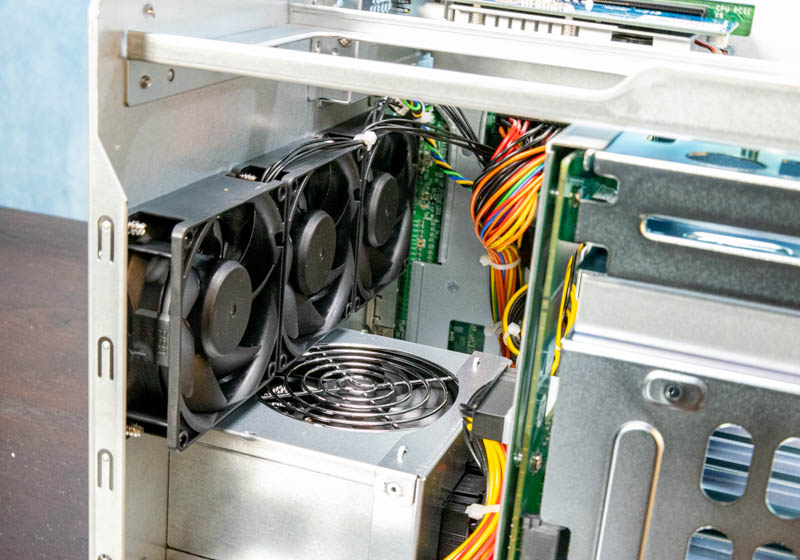
In terms of noise, we saw the following in a 25dba ambient environment as measured from 1m in front of the chassis:
- Idle: 27dba
- Moderate Disk Activity: 31dba
The disk activity is probably what would make one put this a few feet/ meters away rather than directly next to their chair. Still, this is not a unit that most will find needs to be located in a data equipment closet.
Next, we are going to discuss the market impact of this solution, along with our final words.




I have the 9 bay TS-h973AX AMD Ryzen NAS, running QuTS Hero. My first QNAP NAS after a couple of Synology. I specifically bought it for the mix of ZFS NAS dedup and compression with the nice addition of the app ecosystem. Mine stores multiple, very similar linux VDI VMs on an iSCSI connected datastore and is achieving impressive data storage reductions, and I am really happy with the storage performance across the inbuilt 10 and 2.5GBe network ports. I am using 5 Ironwolf HDDs and 2 intel enterprise NVME drive for caching and ZIL log.
I used to work in the enterprise server/storage areas, and this really seems to perform as well as some of the old HP/EMC storage systems I worked with. As well as being my PLEX media server…
I really think this is a significant step-change for SMB/homelab setups, after a good few years of ‘meh’ NAS device updates. I had my last Synology for 5 years, never saw a reason to update it until I saw the QNAP/ZFS solution…
Not so much about this product but the state of the market:
* While I’m glad to see 2.5 Gbps appearing, NBase-T would be preferable. Do you know why it’s shipping on so few products, I assume cost?
* Is there any indication of a next-rev Xeon-D?
QNAP keeps pushing the envelope…nice review!
100W “Idle” seems a bit excessive, does this have a BMC? Is it possible to simply install Linux on it since it’s all standard components?
i want this case with another hardware and OS for home server
Great review, but it lacks recent news regarding Qnap devices around the world facing ransomeware:
https://www.bleepingcomputer.com/news/security/massive-qlocker-ransomware-attack-uses-7zip-to-encrypt-qnap-devices/
Appears to be a pattern of failed security, including hard-coded passwords in backdoors:
https://www.reddit.com/r/qnap/comments/mwo72h/with_all_the_ransomware_attacks_i_highly/
I was close to buying this new unit with 16-drives. Perhaps after some significant improvement!
And six months after being notified of their breached webserver, no remediation:
https://securingsam.com/new-vulnerabilities-allow-complete-takeover/
And cryptocurrency mining, also unfixed:
https://heimdalsecurity.com/blog/unpatched-qnap-nas-devices-targeted-by-unityminer/
Thanks for the great Large QNAP NAS review. STH is comprehensive and just plain forthright and honest every time.
For my SOHO my 1st NAS I is a Synology DS-218+. A little great 2-bay. I upgraded May 2020 to a QNAP TS-253D (another 2 bay). That little TS-X53D family NAS has a few pre-view features its much large big brother. It has multiple 2.5GB ports (easy to port aggregate), many USB ports (compatible with all of the 2.5 & 5Gb Adapters reviewed by STH), and a full PCIe slot (to use any of the many QNAP PCIe 10Gb NIC & NIC/Memory cards).
The QNAP QTS OS does take a long while to boot and shutdown. To me along with the size of the hard drives the up & down times also appears to be related to the number of Apps installed, Snapshots & Virtual machines configured, etc. The variable speed fan is pretty quiet but the constant HD noise along with the Synology NAS HD’s clearly is annoying in a quiet office space.
Synology & QNAP have regular OS software updates and frequent App updates.
no das option for thunderbolt
What was the nuc video, couldn’t find.
Get ready for your product to be infected by ransomware, loose all your files and QNAP not taking any action nor responsibility at all. Stay as far away from QNAP as you possibly can!!
To me, this is overpriced, too power hungry, and deceptive.
It’s not really a DAS, as claimed by the advertising folk at QNAP. It uses Firewire-over-IP for the Thunderbolt connection, so every device on the Thunderbolt bus that is attached to the NAS will be taken over by the NAS (monitors, external PCIe enclosures, and so on). If your PC has only one thunderbolt port, this is a real issue.
Next, consider the price point. For that kind of money, you can buy a really nice SM board like the X10SDV-7TP4F with lots of SATA expansion options, real server features like a BMC, and dual SFP+, two standard PCIe 3.0×8 slots, NVME at 3.0×4, mSATA, a on-board LSI HBA, and so on. Even with a case, 64GB of RAM, two SATADOMs, a Ti power supply, etc. the whole package comes out to ~$2k, and consumes less than 120W with a full eight 3.5″ HDD and six 2.5″ SDD loadout.
Better yet, these are standard components that are easy to replace, not custom stuff that you can only get from QNAP. Add TrueNAS to the setup (Free) and you have a better ZFS storage implementation than QNAP at a lower cost. The only downside is that the TrueNAS UI will make you work a lot harder than the QNAP UX and there are far fewer plug-ins.
As a QNAP NAS owner for about 2 years and witnessing the ransomware attacks I can say that QNAP has not ignored it. They mention it on their forums and their Reddit, they give hotfix software updates, and they tell you what to disable in the NAS until a hotfix is released. They appear very transparent.
To avoid getting ransomware, basically practice general security measures that you would do on any server.
1. Have a firewall router in your home and don’t set your NAS as a DMZ.
2. Only use the built-in admin account to configure a secondary admin account under a unique username and disable the default admin account.
3. Keep SSH disabled when not using it.
4. Disable apps that aren’t being used.
5. BACKUP!! WHILE RAID6 is great, you really should also be backing up on external hardware or the cloud like Backblaze.
Every vendor and every device can be hacked. Keep your attack surface small and be smart.